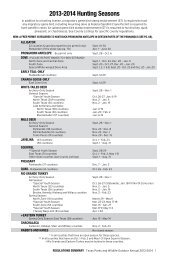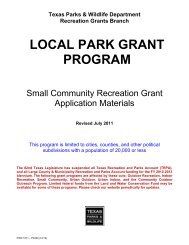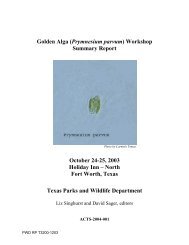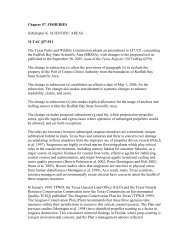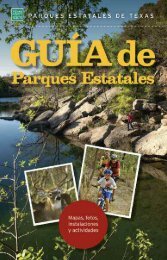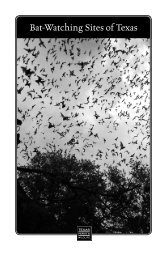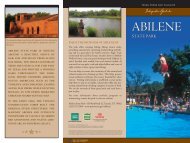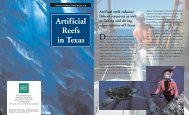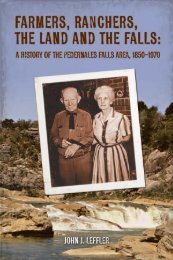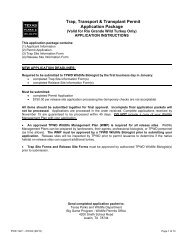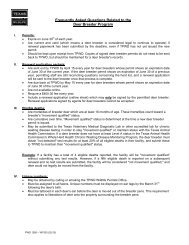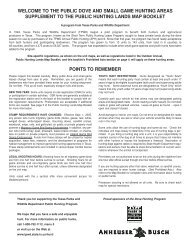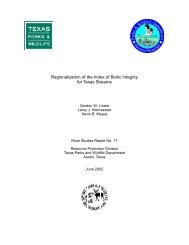Managing Riparian Habitats - Texas Parks & Wildlife Department
Managing Riparian Habitats - Texas Parks & Wildlife Department
Managing Riparian Habitats - Texas Parks & Wildlife Department
You also want an ePaper? Increase the reach of your titles
YUMPU automatically turns print PDFs into web optimized ePapers that Google loves.
texas parks and wildlife<br />
<strong>Managing</strong><br />
<strong>Riparian</strong> <strong>Habitats</strong><br />
F O R W I L D L I F E<br />
MATT WAGNER,<br />
T ECHNICAL GUIDANCE BIOLOGIST
In addition to their<br />
aesthetic and economic<br />
value, riparian areas<br />
perform key ecological<br />
functions.
<strong>Managing</strong> <strong>Riparian</strong> <strong>Habitats</strong> for <strong>Wildlife</strong><br />
1<br />
What is a <strong>Riparian</strong> Area?<br />
<strong>Riparian</strong> areas are the margins of streams, rivers and intermittent draws, where vegetation is strongly influenced<br />
by the presence of water. <strong>Riparian</strong>-dependent plant communities differ markedly from those of the immediately<br />
surrounding non-riparian habitats. While comprising only a small proportion of the total habitat in <strong>Texas</strong>, riparian<br />
zones are some of the most productive for native wildlife. To illustrate their importance, an estimated 80% of<br />
all vertebrate species in the desert southwest depend on riparian areas for at least some part of their life cycle.<br />
Hence, conservation of riparian corridors is critical to the preservation of our native flora and fauna.<br />
The Benefits of a Healthy <strong>Riparian</strong> Area<br />
<strong>Riparian</strong> areas perform key ecological functions that contribute to the health of the entire ecosystem. Nutrients,<br />
detritus, and water are transported into a riparian system from runoff. <strong>Riparian</strong> vegetation adjacent to rivers and<br />
streams serves as a major energy source for aquatic organisms while providing habitat for numerous terrestrial<br />
wildlife species. Trees provide shade and prevent wide fluctuations in water temperature, protecting aquatic<br />
wildlife from the harmful effects of climatic extremes. Stems and roots of riparian vegetation stabilize the soil by<br />
reducing water velocity and minimizing erosion.<br />
Water quality – In addition to trapping sediments due to erosion, the vegetation found along riparian areas<br />
assures water quality by filtering pollutants. By slowing and dispersing runoff that may contain excess nutrients<br />
and pesticides washing down from surrounding upland areas, lush riparian vegetation assures superior<br />
habitat for freshwater fish and other aquatic animals.<br />
<strong>Wildlife</strong> Habitat – The rich diversity of native vegetation found in riparian areas fosters high species richness<br />
and abundance of wildlife. <strong>Riparian</strong> areas are particularly vital to wildlife, as they provide water, shelter,<br />
and food necessary for survival. As the human population continues to grow, however, large areas of riparian<br />
habitat are being altered or destroyed, making it increasingly difficult for riparian dependent wildlife to find<br />
sufficient space to live. Finally, riparian areas serve as important habitat corridors between larger areas of<br />
habitat facilitating dispersal, recruitment, and migration of wildlife.<br />
Economics – Revenues from hunting leases, birdwatching, and other wildlife watching or recreational activities,<br />
can enhance income derived from traditional ranching and farming operations. Attracting potential<br />
wildlife users to private lands not only benefits the private landowner, but also brings added tourist dollars to<br />
the entire region. In addition to contributing to the overall health and stability of adjoining lands, quality<br />
riparian areas have an enormous aesthetic appeal. People and wildlife alike are drawn to rivers. For this<br />
reason, maintaining healthy riparian areas may well translate into higher property values for landowners with<br />
river-front property.<br />
Types of <strong>Riparian</strong> <strong>Habitats</strong> in <strong>Texas</strong><br />
In the High Plains and Rolling Plains regions of <strong>Texas</strong>,<br />
riparian areas comprise a mere 2 to 5 % of the total<br />
wildlife habitat and are, accordingly, extremely important.<br />
The native plant communities of riparian areas in the<br />
Rolling Plains generally have an overstory of cottonwood,<br />
willow, hackberry, soapberry or locust, often associated<br />
with persimmon, bumelia, and mesquite. Many High<br />
Plains riparian zones consist of unwooded, entrenched<br />
draws, frequently dominated by invasive salt cedar. In the<br />
High Plains <strong>Riparian</strong> Area. Photo by Leroy Gene Miller.
2 <strong>Managing</strong> <strong>Riparian</strong> <strong>Habitats</strong> for <strong>Wildlife</strong><br />
Panhandle, riparian areas provide habitat to such wildlife species as red and gray fox, squirrels, rabbits, coyotes,<br />
raccoons, skunks, bobcats, beavers, white-tailed deer, quail, turkey, pheasant, several species of ducks, mourning<br />
doves, red-tailed hawks and prairie falcons, common snapping turtles, and yellow mud turtles. Many neotropical<br />
birds that migrate through <strong>Texas</strong> during the spring and fall make heavy use of these critical riparian habitats.<br />
Some common nesters include Mississippi kites, American kestrels, Western and Eastern kingbirds, scissor-tailed<br />
flycatchers, purple martins, various swallows, robins, warblers, cardinals, buntings, sparrows, blackbirds, orioles<br />
and meadowlarks.<br />
Edwards Plateau <strong>Riparian</strong> Area.<br />
Photo by Leroy Williamson.<br />
Three types of plant communities can characterize the riparian zones of<br />
the limestone-dominated Central <strong>Texas</strong>/Edwards Plateau region:<br />
those dominated by bald cypress and sycamore; pecan and hackberry;<br />
and hackberry and elm. In smaller creeks of the drier western portion of<br />
the Edwards Plateau, netleaf hackberry/little walnut; plateau live<br />
oak/netleaf hackberry; and sycamore/willow communities predominate.<br />
Species such as white-tailed deer, opossum, raccoon, Eastern cottontail,<br />
swamp rabbits, nine-banded armadillo, Carolina wrens, painted<br />
buntings, summer tanagers, yellow-throated and white-eyed vireos, prothonotary<br />
and yellow-throated warblers, are commonly found along the<br />
rivers in this region. In this area, the shallow soils are prone to heavy<br />
erosion, thus threatening water quality.<br />
Although the Trans-Pecos region of <strong>Texas</strong> has less than 5% riparian<br />
habitat, these areas are critically important because of the extreme<br />
diversity of vegetation found there as compared to adjacent areas. Most<br />
of the riparian areas consist of the Rio Grande and Pecos River<br />
drainages. The deciduous riparian woodlands of the Trans-Pecos generally<br />
support plant communities with some combination of ash, cottonwood,<br />
willow, walnut, and hackberry. In areas with lower, shrubby vegetation,<br />
riparian areas consist mostly of mesquite/acacia, and sumac overtopped by cottonwoods, willows or ash.<br />
<strong>Riparian</strong> areas within the Trans-Pecos provide habitat to a large number of wildlife species, including whitetailed<br />
deer, desert mule deer, javelina, mountain lions, black-tailed jack rabbits, quail, raptors, roadrunners,<br />
nightjars, a myriad of flycatchers, and a host of other neotropical migrants and resident songbirds.<br />
<strong>Riparian</strong> habitats in South <strong>Texas</strong> occur mainly along the Nueces and Rio Grande Rivers and associated tributaries.<br />
Mesquite, retama, granjeno, anacua (Rio Grande), live oak, cedar elm, hackberry, and whitebrush are dominant<br />
species. Research has shown that mountain lions prefer riparian areas over adjacent uplands in the South<br />
<strong>Texas</strong> region. Prey items, including feral hogs and javelinas, tend to concentrate in these areas as well. Alligators,<br />
several species of turtles, nutria, and numerous wading birds also can be found in South <strong>Texas</strong> riparian zones.<br />
<strong>Riparian</strong> zones throughout most of the Pineywoods and Post Oak Savannah regions of <strong>Texas</strong> are mainly bottomland<br />
hardwood forests. These forests are subject to frequent flooding. Characteristic trees in lower flood<br />
plains in the Pineywoods region include willow oak, green ash and overcup oak. Water oak, cherrybark oak and<br />
sweetgum tend to occupy the upper flood plains. The swampy flatlands, sluggish bayous, backwaters, and river<br />
drainages of the Pineywoods support stands of baldcypress and water tupelo.<br />
Bottomland hardwood forests harbor an incredible variety of wildlife. A survey by the U.S. Fish and <strong>Wildlife</strong><br />
Service recorded 273 species of birds, 45 mammals, 54 reptiles, 31 amphibians, 116 species of fish and innumerable<br />
invertebrates. This amazing variety of wildlife includes such resident birds as the red-shouldered hawk,<br />
barred owl, and pileated woodpecker, as well as numerous neotropical migratory birds such as Northern parula,<br />
prothonotary warbler, and Kentucky warbler. Game birds include wild turkey, mallard, and wood duck.<br />
Mammals include beaver, swamp rabbit, river otter, bobcat, mink, and white-tailed deer.
<strong>Managing</strong> <strong>Riparian</strong> <strong>Habitats</strong> for <strong>Wildlife</strong><br />
3<br />
Detecting a Degraded <strong>Riparian</strong> Area<br />
Major factors that contribute to degradation of riparian zones in <strong>Texas</strong> include construction of roads, dams,<br />
reservoirs and impoundments, uncontrolled grazing, point and non-point pollution, urban development and<br />
timber cutting. It may sometimes be difficult to recognize the signs of a degraded riparian system when the<br />
condition is not extreme. If possible, compare the tree composition and vegetative structure of a disturbed<br />
riparian area to one nearby that is in better condition. A diverse array of forbs, grasses and wildflowers at<br />
ground level, followed by leafy shrubs and saplings in the understory are signs of a productive riparian area.<br />
Next, take a look at the width and depth of the waterway itself. Wide, gullied streams with cut-banks and<br />
murky water are telltale signs of accelerated erosion problems.<br />
Land Uses of <strong>Riparian</strong> Areas<br />
Grazing<br />
Continuous overgrazing can cause degradation<br />
of riparian habitats, especially in arid<br />
environments. Reducing or eliminating<br />
streamside vegetation will cause bank destabilization<br />
and erosion. An appropriately<br />
planned grazing system will limit the intensity<br />
and duration of livestock grazing, and promote<br />
the natural recovery of the system. A<br />
rotational grazing program that moves cattle<br />
in and out of riparian pastures with sufficient<br />
recovery periods can enhance overall plant<br />
diversity.<br />
When deciding how to prevent livestock<br />
Trans-Pecos <strong>Riparian</strong> Area. Photo by Matt Wagner.<br />
from impacting a riparian area, land managers<br />
have several options. Complete exclusion<br />
of livestock or controlled livestock grazing are two options. Separating riparian areas from other pastures,<br />
thus facilitating the timing, intensity, and duration of grazing in those sensitive areas is another. Either temporary<br />
or permanent fencing can accomplish this to various degrees. If some grazing is allowed, the best strategy<br />
consists of short grazing periods followed by long rest periods. No one grazing strategy fits all situations, and<br />
several variations exist to meet special needs. Three common strategies include the winter grazing system, the<br />
early grazing system, and the three-season rotation system. Winter grazing provides rest to the riparian area<br />
during the growing season. Livestock graze in sensitive areas while plants are dormant. This system promotes<br />
plant vigor, as well as seed and root production. Early grazing can minimize livestock browsing on woody<br />
plants because grazing occurs very early in the growing season. The three-season rotation system utilizes the<br />
riparian pasture in the spring the first year, the summer in the second, and allows the pasture to rest in the<br />
third.<br />
Farming<br />
In riparian areas bordered by cultivation, habitat degradation is often caused by removal of native, perennial<br />
vegetation for annual crops. This results in decreased water quality, as valuable topsoil is lost. <strong>Riparian</strong> buffer<br />
zones should be established. These zones, ideally as wide as possible, protect native vegetation and are especially<br />
important because they act as filters to runoff which may carry silt, nitrates, fertilizers, or pesticides. When<br />
large buffers are not feasible, narrower grassy filter strips on field borders can be highly effective.
4 <strong>Managing</strong> <strong>Riparian</strong> <strong>Habitats</strong> for <strong>Wildlife</strong><br />
Timber<br />
Special silvicultural methods may be used to protect riparian areas. Retention of streamside management zones in<br />
mature hardwood or mixed pine/hardwood forests greatly benefits riparian wildlife. Single-tree or small-group harvesting<br />
should be practiced, leaving the vegetation nearest the water's edge untouched. Objectives for growth of<br />
saw timber are compatible with wildlife management.<br />
Conclusion<br />
Depending on the current condition of the riparian zone, what<br />
results are desired, and how fast results are expected, a number of<br />
different approaches may be taken to restore the health of the riparian<br />
zone and enhance wildlife habitat. Some practices may simply be<br />
stopped, or variously modified, to allow native vegetation to recover<br />
on its own. The area may be actively revegetated with native plants<br />
appropriate to the ecological region. Mechanical means of channel<br />
stabilization may be employed to retard severe erosion. However, be<br />
aware that erecting structures for bank stabilization alone will not<br />
solve an erosion problem. The best solution is found by identifying<br />
and correcting the cause of the erosion and thus minimizing the<br />
effects.<br />
Bald Cypress/Tupelo Swamps of East <strong>Texas</strong>.<br />
TPWD photo.<br />
Much still needs to be learned about the dynamics of riparian areas.<br />
There exists a critical need to manage them more effectively, not only<br />
for wildlife but also for people. The publications listed at the end of<br />
this brochure offer detailed information on measures available to protect<br />
and preserve riparian habitats. In addition, professionals with<br />
the agencies listed below can provide assistance upon request.<br />
For More Information<br />
<strong>Texas</strong> <strong>Parks</strong> and <strong>Wildlife</strong> <strong>Department</strong><br />
4200 Smith School Road<br />
Austin, TX 78744<br />
www.tpwd.state.tx.us<br />
Natural Resources Conservation Service<br />
101 S. Main<br />
Temple, TX 76501-7682<br />
www.tx.nrcs.usda.gov<br />
Lower Colorado River Authority<br />
P.O. Box 220<br />
Austin, TX 78767-0220<br />
www.lcra.org<br />
<strong>Texas</strong> Cooperative Extension Service<br />
<strong>Texas</strong> A&M University System<br />
College Station, TX 77843<br />
http://tce.tamu.edu<br />
<strong>Texas</strong> Forest Service<br />
John B. Connally Building<br />
301 Tarrow, 3rd Floor<br />
College Station, TX 77840-7896<br />
http://texasforestservice.tamu.edu<br />
U.S. Fish & <strong>Wildlife</strong> Service<br />
10711 Burnet Rd.<br />
Austin, TX 78758<br />
http://southwest.fws.gov/statelinks/texaslinks.htm<br />
U.S. Forest Service<br />
506 Hayter<br />
Nacogdoches, TX 75962<br />
www.southernregion.fs.fed.us<br />
Environmental Protection Agency<br />
1445 Ross Ave., Ste. 1200<br />
Dallas, TX 75202<br />
www.epa.gov/earth1r6/states.tx.htm
<strong>Managing</strong> <strong>Riparian</strong> <strong>Habitats</strong> for <strong>Wildlife</strong><br />
5<br />
References<br />
DeBano, L. F. and L. J. Schmidt. 1989. Improving Southwestern <strong>Riparian</strong> Areas Through Watershed Management;<br />
USDA and U.S. Forest Service. General Technical Report RM-182.<br />
Dosskey, M. G., R. C. Schultz, and T. M. Isenhart. 1997. Agroforestry Notes. USDA Forest Service and USDA<br />
Natural Resources Conservation Service. AF Notes 3, 4, and 5.<br />
East <strong>Texas</strong> Woods, Water, and Wetlands. 1997. <strong>Texas</strong> Forest Service.<br />
Frentress, C. D. 1986. Bottomland Hardwoods in <strong>Texas</strong>: Proceedings of an Interagency Workshop on Status and<br />
Ecology. <strong>Texas</strong> <strong>Parks</strong> and <strong>Wildlife</strong> Dept. and U.S. Fish and <strong>Wildlife</strong> Service.<br />
<strong>Managing</strong> Change: Livestock Grazing on Western <strong>Riparian</strong> Areas. 1993. Environmental Protection Agency.<br />
Publication EPA0843-R-93-002.<br />
Messina, M. G., and W. H. Conner eds. 1998. Southern forested wetlands: ecology and management. Lewis<br />
Publishers, Boca Raton, FL. 616 pp.<br />
McMahan, C. A., R. G. Frye, and K. L. Brown. 1984. The Vegetation Types of <strong>Texas</strong>. <strong>Texas</strong> <strong>Parks</strong> and <strong>Wildlife</strong><br />
Dept., Austin, ii +40 pp.<br />
Miller, G. T. and J. Ray. 1996. <strong>Managing</strong> <strong>Riparian</strong> Habitat for <strong>Wildlife</strong> in Northwest <strong>Texas</strong>. <strong>Texas</strong> <strong>Parks</strong> and<br />
<strong>Wildlife</strong> Dept.<br />
Ohmart, R. D. and B. W. Anderson. 1986. <strong>Riparian</strong> <strong>Habitats</strong>. In Inventory and Monitoring of <strong>Wildlife</strong> Habitat.<br />
Washington, D.C.: U.S. Dept. of the Interior, Bureau of Land Management.<br />
Payne, N. F. 1992. Techniques for wildlife habitat management of wetlands. McGraw-Hill, Inc., New York.<br />
549 pp.<br />
Proceedings from a 1991 Symposium on Ecology and Management of <strong>Riparian</strong> Shrub Communities; USDA and<br />
U.S. Forest Service, General Technical Report INT-289.<br />
Wetlands Assistance: A Guide for Landowners. 1995. <strong>Texas</strong> <strong>Parks</strong> and <strong>Wildlife</strong> Dept. PWD BK R2000-020.
4200 Smith School Road<br />
Austin, <strong>Texas</strong> 78744<br />
www.tpwd.state.tx.us<br />
PWD BR W7000-306 (6/04)<br />
Dispersal of this publication conforms with <strong>Texas</strong> State<br />
Documents Depository Law, and it is available at <strong>Texas</strong> State<br />
Publications Clearinghouse and/or <strong>Texas</strong> Depository Libraries.<br />
NOTICE<br />
<strong>Texas</strong> <strong>Parks</strong> and <strong>Wildlife</strong> <strong>Department</strong> receives federal financial assistance from the U.S. Fish and <strong>Wildlife</strong> Service. Under Title VI<br />
of the Civil Rights Act of 1964, Section 504 of the Rehabilitation Act of 1973, Title II of the Americans with Disabilities Act of 1990,<br />
the Age Discrimination Act of 1975, and Title IX of the Education Amendments of 1972, the U.S. <strong>Department</strong> of the Interior and its<br />
bureaus prohibit discrimination on the basis of race, color, national origin, age, disability or sex (in educational programs). If you<br />
believe that you have been discriminated against in any <strong>Texas</strong> <strong>Parks</strong> and <strong>Wildlife</strong> <strong>Department</strong> program, activity, or facility, or if you<br />
desire further information, please call or write: The U.S. Fish and <strong>Wildlife</strong> Service, Office for Diversity and Civil Rights Programs -<br />
External Programs, 4040 N. Fairfax Drive, Webb 300, Arlington, VA 22203, (703) 358-1724.



